
Logan and Albert Conservation Association

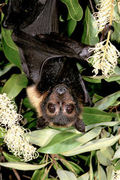 The flying fox is at the forefront of many newspaper stories since the 2011 outbreak of Hendra. All horses that are tested positive are euthanized if they do not die of virus first. This is because of difficulty of keeping the large animal within required biosecurity framework.
The flying fox is at the forefront of many newspaper stories since the 2011 outbreak of Hendra. All horses that are tested positive are euthanized if they do not die of virus first. This is because of difficulty of keeping the large animal within required biosecurity framework.
While it is a tragedy to lose any human life ,4 of 7 people exposed to Hendra have died - all men, it is understood that Hendra cannot be transmitted directly from the bat to a human - the horse is needed as an intermediary for the human to contract the virus. Why are communities more upset about this possibilty than deaths on roads, death from air pollution, deaths from accidents in hospitals, deaths from coal mining accidents to name just some of many.
Do we assume that when humans cause death from accidents it is an unavoidable part of living in our society? We can contract may illnesses directly from animals such as cats, dogs, cows, pigs and more. These are called zoonoses. Zoonotic diseases can spread through a variety of means such as working closely with livestock, household pets, exhibited animals or wildlife, by coming in contact with soil or water contaminated by animals.
Practising good personal hygiene, wearing protective clothing, maintaining healthy animals and undertaking vaccination where appropriate, can minimise the risk of some animal-borne diseases infecting people.
DPI have information about protection of horses on their website here.
Flying foxes often visit properties where native eucalypts, bottlebrushes, lilly-pillies, figs and melaleucas are flowering. Blossoms are their primary source of food. They will also feed on palm seeds and exotic fruits when native food is less abundant.
Horse owners should follow these steps to reduce the risk of their horses becoming infected with Hendra virus:
Australian Bat Lyssavirus is caused by a bite or scratch from an infected bat. Carers pay over $200 of their own money to be vaccinated so they can care for injured / orphaned bats.
IT IS ESSENTIAL YOU DO NOT ATTEMPT TO CATCH OR MOVE FLYING FOXES / BATS UNLESS YOU HAVE BEEN VACCINATED.
You can read more about Zoonotic diseases at DPI website here.
A 300,000-strong bat colony is set to be "moved on” from Gayndah in the next five weeks – but where it will go, nobody knows. North Burnett Regional Council workers will start cutting branches from the trees where the animals roost in about five weeks time. It is a move that will pave the way for future flying fox colony relocations, with the Department of Environment and Resources pouring $40,000 into monitoring the impacts of dispersing the animals and the risk of spreading hendra virus. "We have to wait about five weeks until the little bats are able to fly before we move them on,” Mayor Joy Jensen said. "Where are these bats going to go? No one knows. But the permit has been granted for the full township of Gayndah so at least we know we can work on them until they leave.” Ms Jensen said residents were sick and tired of the bats, which not only posed a health risk but had caused "immeasurable” damage to the town’s riverbank since they arrived in September last year. A number of businesses had also been hit hard by the "smelly” and "noisy” colony, particularly the ones located along the river. "There has been no explanation as to why they’re in such large numbers. It’s an unbelievable sight to see that many bats hanging in so few trees,” Ms Jensen said. Anyone who couldn’t understand why residents were so distressed should come and have a look for themselves, Ms Jensen said. "It hasn’t been a pleasant situation and it’s driven a lot of people to say and threaten to do a lot of things they wouldn’t consider under normal circumstances. "Residents feel the bats were given priority over them.” *Fraser Coast Chronicle
Logan - Albert Waterways Summit hosted by Logan City
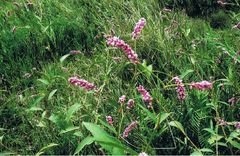 LACAs northern spokesperson Barry Fitzpatrick has been advocating tirelessly that all levels of government and community must take
LACAs northern spokesperson Barry Fitzpatrick has been advocating tirelessly that all levels of government and community must take 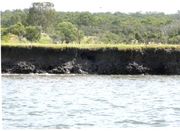 some action in response to the failed HEALTHY WATERWAYS REPORTS.
some action in response to the failed HEALTHY WATERWAYS REPORTS.
Saturday 23 July saw the fruitition of successful lobbying when Logan City Council hosted the WATERWAYS SUMMIT at the Logan entertainment. 125 people from a range of backgrounds joined together to take some positive actions to redress the sorry situation. All present committed - pledged - to continue - to rebuild the rivers systems. Local papers across Logan and Scenic Rim have been reporting on this process.
Barry has also been engaged with local community in the Cornubia Wetlands area. This ecologically functioning wetlands is an example of a healthy wetlands sysytem which keeps itself clean. There are no mosquitoes as the micro-organisms in the water are the natural controlling agents. It is only when man steps in and changes a balanced system - using poison for a fast fix or planting with non endemic species that the balanced is tipped.
Barry produces newletters for the local community as part of the successful Logan Envirogrant application. The last newsletter includes information about the Waterways Summit.. It is available to read here. Cornubia_Wetland_News_4web.pdf
Cornubia_Wetland_News_4web.pdf
Plant in image above is the federally listed endangered species Persicaria elatior - one of the many species making up the wetland habitat area. Image of eroded river banks illustrates one of the past mismanagement issues.
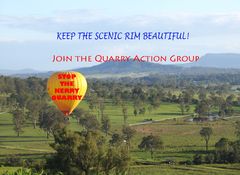 Scenic Rim Regional Council has been surpised by the huge number of objections against the proposed Kerry and Christmas Creek Quarry. Council has now received over 800 submissions. The ERA application is for a quarry to operate in the quiet rural area on Erin View and Glandore Roads. The notification period finished on 29 July, 2011.
Scenic Rim Regional Council has been surpised by the huge number of objections against the proposed Kerry and Christmas Creek Quarry. Council has now received over 800 submissions. The ERA application is for a quarry to operate in the quiet rural area on Erin View and Glandore Roads. The notification period finished on 29 July, 2011.
Some glitches in data entry of submissions on SRRC website has to date not given an accurate picture of submissions received.
Concerned residents have had public meetings and arranged for volunteers to collected submissions from all over the region. Objections have been received from tourists visiting the region who are concerned that a quarry would reduce the tourism, impact the environment while causing chaos on the already choked road system.
The Quarry Action Group (QAG) believes that approval of a quarry in this area will cost jobs in the legitimate rural areas of farming, cropping, grazing and tourism. They suggest that there is little or no economic benefit in approving this type of industrial development in this rural zone. The group suggests that the impacts on the rural roads is more than the ratepayers of the region could afford to maintain. They go on to point out that there are alternative sites in the State Development Area (SDA) that would be much more suitable and would be supported by infrastructure such as good quality roads and reticulated water. They also point out that environmental and health impacts - including vegetation clearing, dust, noise, operational times (24/7) air quality, water quality, pollution, safety of school children, etc- have not yet been fully studied or suggested mitigation included under the application.
Concerned residents are asked to continue to contact their local Councillors as well as State and Federal members to voice concerns over the quarry. Submissions may have closed but we all have a right to have our politically elected representatives hear our concerns.
The Quarry Action Group (QAG) will be actively involved to help residents and tourism visitors communicate their concerns that their values and appreciation for the amenity offered by the natural environment will be destroyed by the proposed industrialized quarrying activities of Kerry Quarry. QAG will continue to lobby at all levels to protect the natural assets of the area. A Tourism Taskforce has recently been established for Scenic Rim.
What impact wil the blasting have on the horse races? With $7 million to revamp the racetrack from federal money the sport / business of racing will undoubtedly be impacted by 24/7 operations.
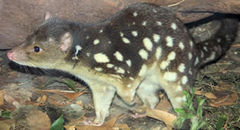 The elusive cryptic spotted-tailed quolls are around with many sightings recorded in Greenbank, North Maclean, Chambers Flat and nearby areas.. Wildlife Queensland have a QUOLL SEEKERS NETWORK. The image is that of a quoll in captivity at Currumbin Wildlife Sanctuary on the Gold Coast.
The elusive cryptic spotted-tailed quolls are around with many sightings recorded in Greenbank, North Maclean, Chambers Flat and nearby areas.. Wildlife Queensland have a QUOLL SEEKERS NETWORK. The image is that of a quoll in captivity at Currumbin Wildlife Sanctuary on the Gold Coast.
Australia has four species of quoll: the spotted-tailed, the northern, eastern and western quoll. The spotted-tailed quoll and the smaller northern quoll are both found in Queensland. Spotted-tailed quolls are Australia's largest native marsupial carnivore.
QSN Quoll Seekers Network is free to join and welcomes and encourages new members. There is also a quoll sightings form which LACA encourages you to use. We also ask that if you see a spotted-tailed quoll in Logan or Scenic Rim areas you contact LACA President Anne Page This email address is being protected from spambots. You need JavaScript enabled to view it.. This species is federally protected under EPBC Act which means that development which could potentially impact on the survival of the species should be referred to the federal government.
Location map for species is available here. and the draft "significant impact" guidelines can be accessed here.
Queensland Government introduced a new Policy ( 2007) which seeks to maintain the long-term availability of major extractive resources by protecting these resources and their main transport routes from incompatible land uses. Incompatible development within areas identified as key resource areas will be excluded as of September 2007, providing increased protection and secured viability of the extractive industry in some parts of Queensland. The new State Planning Policy (SPP) and Supporting Guideline, which was adopted under the Integrated Planning Act 1999 (Qld) took effect from September 2007. It will have positive ramifications for developers, miners and associated entities who seek approval for extractive activities within a key resource area.
Myrtle rust - gum trees and koalas
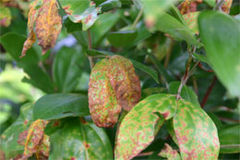 Biosecurity Queensland (BQ) is leading the response to myrtle rust by working with industry to restrict trade of infected plants; track distribution and range of host species; and provide advice on minimising its impact. DERM is working with BQ to prevent the disease's avoidable spread. Myrtle rust was first found in Queensland in December 2010. Since then, it has been found in four national parks—Kondalilla in the Sunshine Coast hinterland and Nicoll Scrub, Springbrook and Lamington in the Gold Coast hinterland.
Biosecurity Queensland (BQ) is leading the response to myrtle rust by working with industry to restrict trade of infected plants; track distribution and range of host species; and provide advice on minimising its impact. DERM is working with BQ to prevent the disease's avoidable spread. Myrtle rust was first found in Queensland in December 2010. Since then, it has been found in four national parks—Kondalilla in the Sunshine Coast hinterland and Nicoll Scrub, Springbrook and Lamington in the Gold Coast hinterland.
While there is no known threat to people, individuals can help reduce the spread. Since this highly infectious fungal disease affects the main food source for koalas, it would be naive to minimise the impacts this plant disease may have on the long term survival of the koala. Another threat to contend with.
The Myrtaceae family includes many Australian native species, such as lilly pillies, water-gums, paperbarks, turpentines and eucalypts. When severely infected, young plants and new growth may become stunted and, possibly, die. Read more at DERM website.
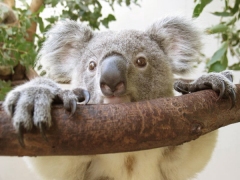
ARE THEY ENDANGERED?
Every day newspapers and websites report information about the increasing threats to the long term survival of our iconic koala. Community and some political concern has persuaded federal government to have an inquiry to determine the status - level of legislated federal protection that is needed to avoid extinction of Australia's much loved koala.
Federal Minister for Environment MP Tony Burke has the responsibility to make that determination. This will not happen until
 Who is wearing blinkers?
Who is wearing blinkers?
Whichever South East Queensland council are you live in there are plans for urban, industry, mining and infrastructure expansion - all meaning loss of bushland vegetated areas. The koala has a very specialised diet - eating only from a range of 17 eucalyptus species. We see huge old gums cut down for a road. Old growth trees and forests are critical not only for koalas but many other species using that habitat. Humans are able to build roads within a short few months or years. We cannot grow forests even in 30 years.
How much does it cost to build a forest? Millions of dollars! This economic cost needs to be added to the cost of the road. Why do we bother with our efforts to replace lost habitat? Do we do it for the animals? In reality governments do it to appease the general community. Perhaps there is a growing realization, that humans also need the forests?
Worldwide there is acceptance that nature has a value - but when those who want to destroy the natural environment are asked to pay compensation then they cry foul!
ELANORA residents' anger over a proposed 15m microwave tower belonging to water retailer Allconnex was provoked further yesterday when tree-loppers cut down two mature trees and only spared a third giant gum after they began filming and journalists arrived on the scene http://www.goldcoast.com.au/article/2011/06/04/320871_gold-coast-news.html
How much is a koala worth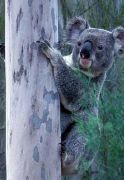 ? How many exist in their natural bushland areas?
? How many exist in their natural bushland areas?
Can you imagine a world without koalas?
Where would Australia be without them and the $2.5 billion a year in tourism they help bring in?
This is the value given by CEO Deborah Tabart of Australian Koala Foundation in a recent article about the unique mapping tool available on the AKF website. Although it's free to access, the information cost $8 million and thousands of volunteer hours to develop. Everyone in the world can now look at over 2000 koala habitat sites where 100,000 trees have been individually measured. Landowners can mark their own koala sightings and developers can see where koalas live. Check out the mapping tool here.
Not all landowners are happy to share their land with koalas - developing for housing or industry.In 1923 it was thought that, from an original population of over 10 million, there were as few as 45,000 koalas left in Australia. Now with 80 per cent of koala habitat cleared for buildings, roads, hard infrastrucure and resource exploration that number is far lower. For a koala, 'no tree' means 'no me'. Read the article here.
Unfortunately the property industry feels no obligation to help protect this unique Australian marsupial - claiming that houses would cost more - obviously passing on all costs to the consumer. Their concerns are reported in this Financial Times article.
The current Senate Inquiry into the status, health and sustainability of Australia's koala population with an interim report tabled 13 May 2011, advising that the committee now intends to table its final report on Wednesday, 24 August 2011.
The submissions received can be read here.
The conservation movement - and LACA Logan and Albert Conservation Association especially - believe the long term survival ie health and sustainability of the koala in Queensland will only be achieved with its being listed as endangered under Australia's EPBC Act.
If you share our concerns, consider writing to your representative as well as Minister Tony Burke who is tasked with the responsibility of making a ruling on the future status of the koala. Current management plans and policies do not protect the koala's habitat and food source. Science is still learning about the ecology and behaviours of the koala but I think there is little doubt that if we clear trees for housing then the koala's survival is limited.
Legislation that has planning power, plus tax or financial incentives to encourage and support private landholders to protect biodiversity are part of the necessary foundation stones, if Australia is going to save the koala on private land. NO TREE NO ME - sums up what we need to do.